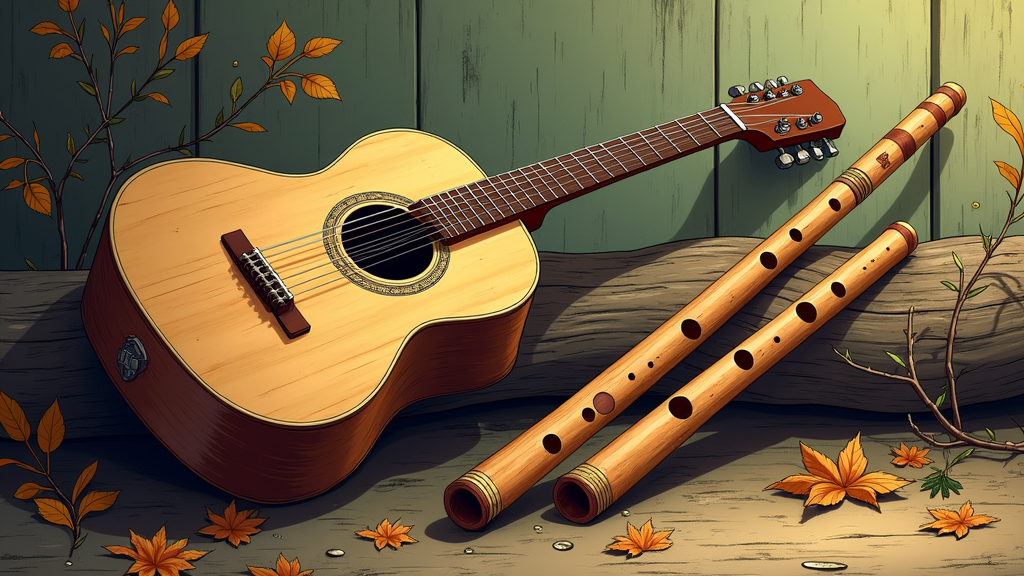
The Role Of Storytelling In Folk Songs
I have always been fascinated by the deep connection between storytelling and music. Folk songs have carried important messages, memories, and traditions over generations. They are a unique blend of simple tunes and rich narratives passed down through the years. I check out how these songs keep history alive and help communities understand their roots. The simplicity and sincerity in folk songs offer listeners a chance to connect with lived experiences and cultural heritage in a very genuine way.
Historical Roots and Cultural Importance of Folk Song Storytelling
Folk songs emerged as an oral tradition in communities where everyday people voiced their history, beliefs, and daily life through music. These songs were created not by professional artists but by locals who wished to record significant events and shared experiences. They captured local legends, historical milestones, and even hardships that are often absent from official records. Over time, these musical narratives have functioned as living archives, preserving the essence of community life with authenticity and heart.
Throughout the centuries, folk songs have offered a window into the traditions and values of various societies. Their clear, unpretentious lyrics and memorable melodies allow new generations to stumble upon deep cultural heritage in an engaging manner. As communities encountered change and hardship, the songs adapted to reflect social issues, celebrate local heroes, and express collective emotions. This natural evolution underscores the role of folk song storytelling not only as artistic expression but also as an important educational tool.
Core Elements of Storytelling in Folk Songs
One of the defining features of folk songs is their reliance on plain, accessible language. The straightforward wording makes these tunes easy to remember and share, ensuring that the narrative remains intact over many retellings. The simplicity in language allows listeners to grasp the story without getting lost in overly elaborate phrasing.
Another central element is repetition, which steps up the storytelling process by reinforcing the main ideas. Repeated phrases and choruses help to anchor themes and ensure that the message is passed along with clarity. This rhythmic repetition not only makes the narrative stick in the mind but also gives the song a musical quality that can be both soothing and energizing.
Imagery and symbolism are also key to folk song narratives. By drawing on familiar images—such as changing seasons, flowing rivers, and vast landscapes—these songs evoke emotions and set vivid scenes. Such symbols form a bridge between personal memory and communal identity, enabling listeners to connect their own experiences with the wider cultural history embedded in the song.
The structure of folk songs is typically straightforward, following a clear beginning, middle, and end. This classic narrative arc makes the story easy to follow and allows for deep emotional connection even when the language appears simple. Each part of the song works together to convey both immediate storytelling and layered cultural meaning.
Techniques Employed in Folk Song Storytelling
Folk songwriters put considerable thought into their choice of melody and diction. A catchy, memorable tune is essential as it strengthens the impact of the lyrics, ensuring that even when words change slightly in each telling, the overall feel remains consistent. Musical composition in folk songs is designed to stay in the listener’s memory for years.
Incorporating local dialects and accents is another effective technique. This approach grounds the song in a specific cultural context and lends a sense of authenticity to the narrative. The use of colloquial expressions makes the song more relatable and helps listeners feel a closer connection to the culture from which the tune originated.
The overall structure of the lyrics is carefully organized. Many folk songs start with an introduction that sets the stage by describing a scene or a character, then move into a sequence of events or conflicts, and finally conclude with a reflection or moral takeaway. This deliberate progression aids in clarity and ensures the central message is communicated effectively to all audiences.
Refrains and choruses are often interwoven into the song to create beats that invite communal participation. When audience members join in, the performance transforms into a shared experience that strengthens community bonds. The repetitive nature of these segments further cements the narrative in collective memory.
Additionally, improvisation plays a significant role in traditional folk music. Performers sometimes modify verses or add new lines to reflect current events or personal insights. This flexibility allows the songs to remain vibrant and relevant, while still preserving the original story’s essence.
Challenges and Considerations in Interpreting Folk Songs
Interpreting folk songs in today’s context can be challenging. The language and references used in these songs are deeply rooted in specific historical and cultural circumstances, meaning that some allusions may be unfamiliar to modern audiences. As language evolves and social contexts shift, the original meanings of certain phrases and symbols can become obscured. This makes it very important to consider historical context when unpacking these narratives.
One major challenge is retaining the originality of the song’s message while acknowledging the natural alterations that occur during oral transmission. Each time a folk song is retold, subtle variations may arise that slightly shift its context. Scholars often compare different versions to better understand these shifts and to preserve the integrity of the original narrative.
When evaluating folk songs, several key areas deserve attention:
- Preservation Techniques: Methods such as recording live performances and creating digital archives help safeguard the original versions of these songs.
- Cultural Adaptation: As societal values evolve, folk songs are updated to reflect contemporary issues while still honoring their historical roots.
- Transmission Across Generations: The oral tradition naturally leads to variations, adding layers of meaning that can both enrich and complicate the original story.
- Understanding Symbolism: Examining the symbols and metaphors specific to the time and place of origin is essential for a full appreciation of these narratives.
Modern technology has played a crucial role in addressing these challenges. Digital tools now allow researchers to compare multiple versions of the same song, uncovering subtle differences and tracking their evolution over time. Such comparative studies help maintain a connection to the song’s original cultural context while also embracing its living nature.
Ultimately, interpreting folk songs requires a balanced approach that respects both historical tradition and contemporary perspectives. Staying sharp to nuanced changes in language and meaning is very important in this ongoing process of cultural understanding.
Advanced Perspectives on Folk Song Narratives
Beyond their simple surface narratives, folk songs are imbued with deeper layers of symbolism and cultural commentary. A closer analysis reveals that these songs are much more than catchy tunes; they are complex expressions of human emotion and social experience. Local imagery and metaphors are frequently employed to comment on universal themes such as love, loss, and the inexorable passage of time.
Experts in musicology and cultural history often map out the intersection of lyrical content and musical arrangement. They examine how choices in key, tempo, and instrumentation contribute to the overall emotional message. These musical details act as a sort of coded language, adding depth to the verbal narrative and prompting listeners to read between the lines.
Advancements in digital technology have furthered our understanding of folk songs by enabling detailed comparison of different versions. Such digital analysis highlights changes in language and melody that have occurred over decades or even centuries, thereby revealing the dynamic evolution of these traditional narratives. This sophisticated examination not only traces musical style shifts but also uncovers the gradual transformation in cultural context.
The relationship between the narrative and the environment is another aspect of advanced interpretation. Descriptions of natural landscapes and seasonal changes are often intertwined with the emotions conveyed in the song, creating a multi-layered experience that reflects both personal sentiment and community identity. This melding of music and nature enriches the storytelling, making each performance a unique articulation of its cultural backdrop.
Frequently Asked Questions
Question: What makes folk songs effective as storytelling vehicles?
Answer: Their clear language, catchy melodies, and evocative cultural symbols combine to create narratives that resonate deeply with listeners.
Question: How do folk songs evolve over time?
Answer: Folk songs continuously change through oral transmission. Each retelling introduces subtle variations that reflect local influences and societal changes, while the core narrative remains intact.
Question: Can modern technology influence our understanding of folk songs?
Answer: Yes, digital recording and analysis have opened new avenues for preserving and examining these songs, offering insights into their evolution and historical context.
Question: Why do folk songs remain relevant today?
Answer: They capture universal human experiences and uphold cultural traditions, bridging the past and present in a way that continues to speak to audiences of all ages.
Final Reflections on the Role of Storytelling in Folk Songs
The power of folk songs lies in their unique ability to merge simplicity with deep cultural insight. These musical narratives act as living documents, capturing the voices, emotions, and experiences of communities throughout time. They remind us that history is not only chronicled in written records but is also sung, felt, and shared in the rhythms of everyday life.
Festivals, community gatherings, and casual get-togethers continue to celebrate these timeless tunes, ensuring that each performance connects people across generations. In listening to a folk song, one may find echoes of personal memories as well as the broader cultural tale, making the experience both intimate and universal.
The adventure of understanding folk songs is ongoing. Every rendition can reveal new layers of meaning, inviting us to dive into the past while looking forward to future interpretations. Recording, analyzing, and sharing these songs not only honor our heritage but also nurture a living tradition that evolves with the times.
Ultimately, folk songs show us that storytelling is very important for maintaining cultural identity and fostering community bonds. They remind us that even the simplest melodies can carry a wealth of emotion and history, bridging diverse experiences and generations. In wrapping up, remember that these narratives are not just about the music—they are about our collective memory, shared traditions, and the enduring human spirit.
Shop Tip
Storytelling in folks on Amazon
Make your own folk website online!
Turn your passion into profit today and start your own online journey. Learn how to create and grow your website withna fabulous community and join for free!






